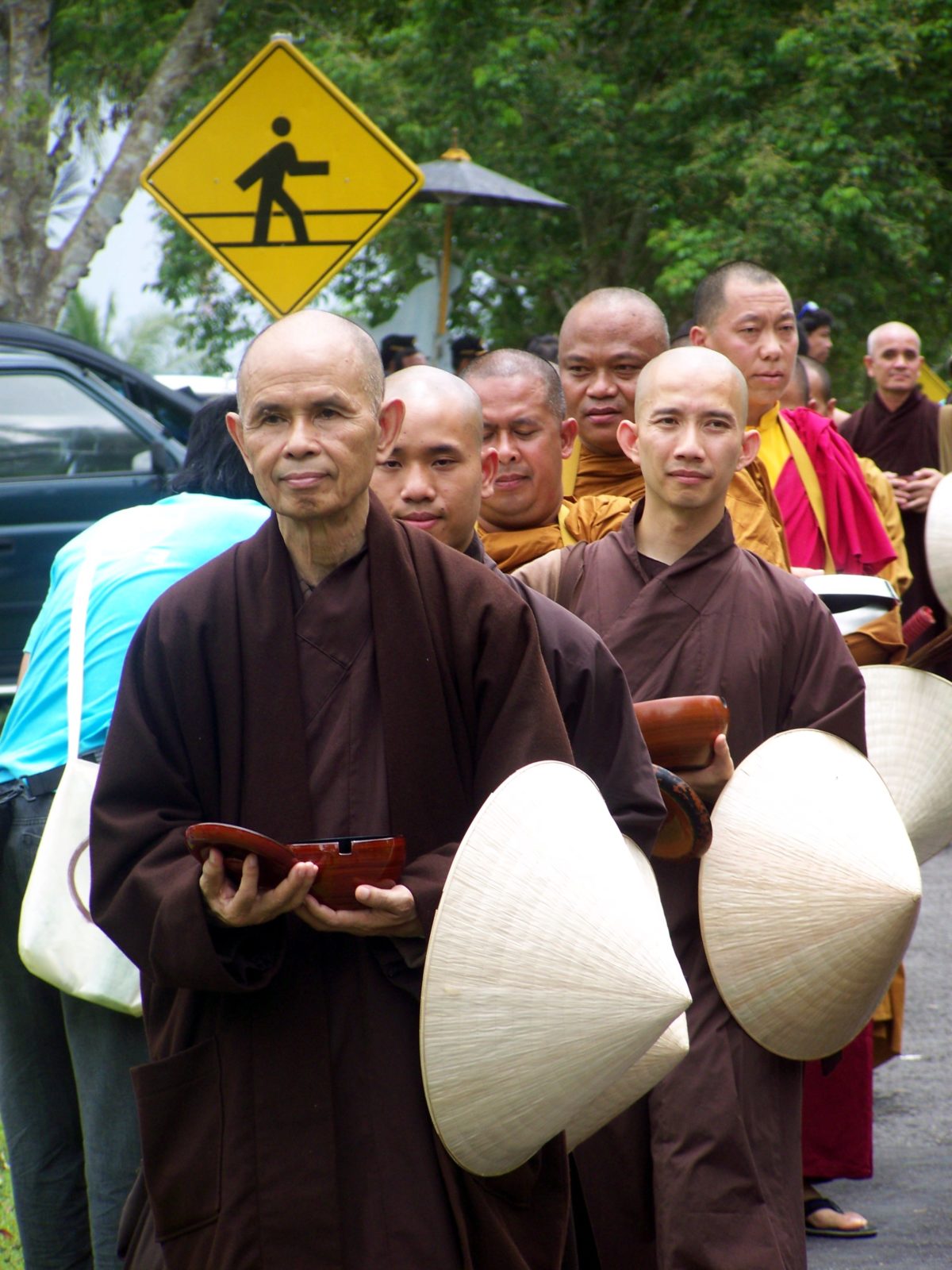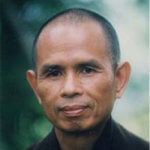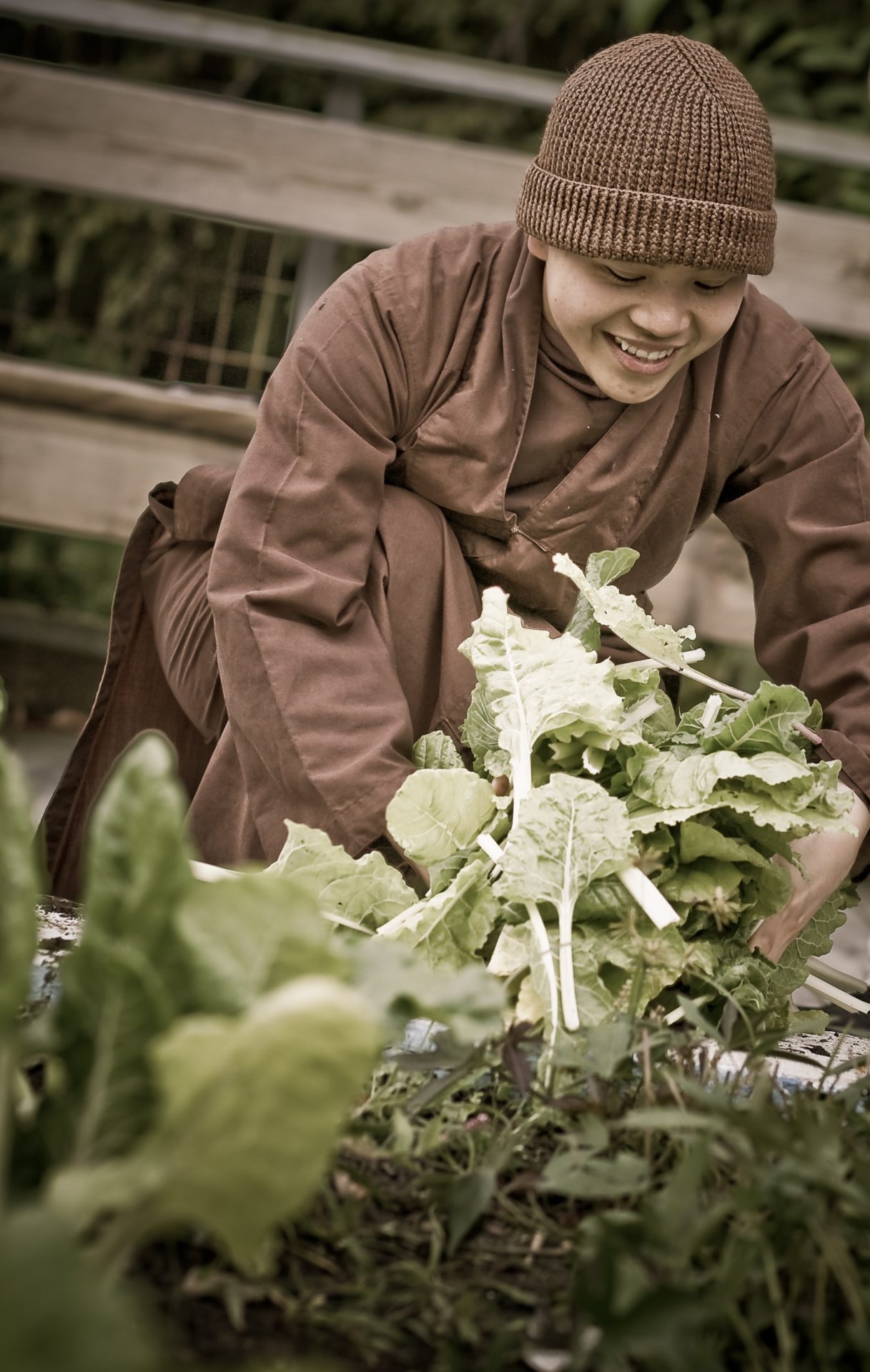Part Two
By Thich Nhat Hanh in October 2017
Retreat on Buddhist Psychology
Key West, Florida
November 7, 1997
“Handling Strong Emotions,” Part One, was published in the Summer 2017 edition of the Mindfulness Bell.

This is a song I wrote that you might like to use to lullaby the blocks of sorrow and pain in you.
Part Two
By Thich Nhat Hanh in October 2017
Retreat on Buddhist Psychology
Key West, Florida
November 7, 1997
“Handling Strong Emotions,” Part One, was published in the Summer 2017 edition of the Mindfulness Bell.

This is a song I wrote that you might like to use to lullaby the blocks of sorrow and pain in you.
It rains softly outside and yet I feel the sadness and the sorrow coming up in me. Please go to sleep, my little pain, and let my in-breath and out-breath embrace you tenderly. I know you are there, and I do my best to take good care of you. You know, I am trying to plant and water the seeds of harmony So that tomorrow from the soil of my consciousness flowers of peace and joy and forgiveness will bloom for everyone. Please go to sleep, my little knots, my little pain. With this practice, there will certainly be a transformation, and tomorrow we’ll be able to accept and love each other.
The blocks of pain and sorrow, anger and despair are here. When they sleep in the depth of our store consciousness, we feel we can survive. But they want to emerge. And because this has brought us suffering in the past, we try to prevent them from coming up.
[Thay draws a circle on the board, with a line through the middle. Thay points to the lower section and then the upper]. This is the basement of the house; this is the living room. Our policy is to occupy the living room so that these unwanted guests from the basement have no chance to come up.
If we don’t do anything, our internal formations, including pain, sorrow, despair, and craving will manifest. We’ll have to seek ways to satisfy our craving, to still our discomfort, and we won’t be at peace. So to distract ourselves we turn on the television, we call someone or pick up a book. We don’t have the courage to stop our activity and go back to ourselves, letting something from the basement emerge. Our daily practice becomes avoiding ourselves to prevent the blocks of pain and suffering from coming up. But the guests we’ve invited to distract us may also intoxicate our store consciousness because they carry elements of violence, hatred, uncertainty, discrimination, and fear. We make the situation worse when we run away.
MINDFUL CONSUMPTION
Before you consume something, ask yourself whether you are going to absorb toxins into your body or your consciousness from it. The family around the table should practice collective mindfulness meditation to see whether the food contains toxins. This is the practice of mindful consumption. Fear, hatred, discrimination, violence, and despair can be identified in items that we consume every day. If we want to protect ourselves and the collective body and consciousness of our family and society, the practice of mindful consumption is essential.
On every package of cigarettes in this country, there is an inscription: Beware, smoking may be hazardous to your health. Mindfulness has become the law! Now it is a delight to travel on a nonsmoking flight. We have worked very hard collectively to bring about mindfulness of consumption.
We should have the same mindfulness about alcohol. On every bottle of alcohol, there must be a warning: Be aware: drinking might break up your family, destroy your life, and cause a lot of accidents on the roads. Alcohol has destroyed so much of our society and caused so much death. It has broken up families, and children growing up in these families look like hungry ghosts.
Mindful consumption helps us be more careful about inviting guests into our living room. The longer they stay, the stronger the seeds in the store consciousness become. That is the first danger that comes from the blockade of our pain.
The second danger is that we cause bad circulation in our psyches. Mental formations have to be able to circulate freely, just like our blood. If our blood does not circulate well, many kinds of diseases may result. If we prevent free circulation in our psyches, it may result in mental illness. First we suppress our blocks of pain, and then a few years later we begin to see symptoms of depression, of fear, of panic. So we go to the doctor to get drugs, but what we really need is to allow the elements of our psyche to freely circulate. It is essential to remove the blockade and allow these things to emerge.
We are afraid that they will overwhelm us, and we will suffer so much that we will be tempted to commit suicide, because we think that suicide is the only way to stop the suffering. But according to the Buddha, it is possible to learn how to generate a second kind of energy, the energy of mindfulness, which will help us embrace, recognize, and transform the first kind of energy. For mindfulness to be strong enough to do this, you have to practice mindful walking and mindful breathing; you practice doing things quietly and mindfully. Eventually you’ll have enough mindfulness to take care of the afflictions.
The practice is not fighting; it is taking care. When the mother hears her baby crying, she embraces the baby. Our practice is the same. Every time our baby cries, we have to be present. “Darling, I’m here for you. I will take good care of you.”
At first, the mother does not know what is wrong with the baby, but the baby still gets relief. The mother is made of the energy of caring and loving kindness, and the baby feels that energy penetrating into his body. When mindfulness embraces our pain, it does not know the true nature of the pain, but it still gives relief. The energy of mindfulness penetrates into that painful zone of energy, like sunshine penetrating a flower. In the morning, the photons in the sunshine penetrate the flower until the flower opens and shows herself to the sun.
So mindfulness begins to penetrate the pain, and that brings relief. Recognizing and embracing your pain is helpful even if you don’t practice looking deeply. Every time you do this, the pain will stay for a while and then will become a seed again. There will be a cease-fire. If you know how to use mindfulness to embrace and recognize pain in you, that pain will lose some of its strength.
If mindfulness continues, the block of pain will reveal its true nature, and there will be a breakthrough. That is the practice of looking deeply. The first aspect of meditation is calming, stopping, concentrating, and relieving. The second aspect is looking deeply. After embracing the baby for a few minutes, the mother discovers what is wrong. He may be hungry, he may have a fever, or his diaper may be too tight. Then the mother can change the situation quickly. So the function of mindfulness is to do this for the block of pain that manifests.
THE FIVE REMEMBRANCES
We have fear in us, and we are afraid to face it. The Buddha advised the monks and nuns to invite their fear up every day and say hello to it. This is the practice of the Five Remembrances. “I am of the nature to grow old; I cannot escape old age.” Everyone has a secret fear of growing old, and we don’t want to think about it. The Buddha said, “Don’t be afraid; bring it up and smile to it.”
“I am of the nature to die; I cannot escape dying. I am of the nature to get sick; I cannot escape sickness. All the people and everything I love and cherish today, I will have to abandon one day. I cannot bring them with me.” These are hard facts that you don’t want to think about, but the Buddha advises you to bravely confront this reality. Bring it up from the bottom of your store consciousness, look at it, smile to it.
The last remembrance is: When I die, I will not be able to bring anything with me except the fruit of my action. What I have done, what I have said, and what I have thought constitute my action, my karma. You have to smile at the hard fact that you are subject to old age, to death, to sickness. You have to say goodbye to the person you love the most and to the things you cherish the most in this life, and accept that the only thing you can bring with you is your own karma, your own action.
The Buddha advised us not to be afraid of the blocks of fear and craving and despair in us, but to invite them up, look directly at them, and smile to them. Why? Because every time we greet them, they lose some of their strength. Your confidence increases, and you lose a lot of your fear. The third advantage is that you’ll restore the good circulation of your psyche, and eventually the symptoms of your mental illness will begin to disappear.
We can do this alone, or we can do it with the support of a therapist or a spiritual friend. We sit close together and invite the fear to come up; we recognize and embrace it together. We need therapists who have a strong energy of mindfulness, and we need a Sangha for the work of healing and transformation.
INTERPENETRATION AND INTERBEING
All seeds and formations have the nature of interpenetration and interbeing. Interpenetration means: in the one, you see the all. When you look deeply into a flower, you see the whole cosmos. You see the flower, the sunshine, the rain, the earth, the minerals, the gardener, time, space. You see everything. The deepest teaching of interconnectedness in Buddhism is presented by the Avatamsaka Sutra. This idea also exists in Christianity. The Father is in me, and I am in you. You are also in me.
The nuclear scientist David Bohm proposed the terms, “explicate order” and “implicate order.” In the explicate order, everything exists outside of everything else. The rabbit exists outside of the rose, the table exists outside of the forest, you exist outside of me, and so on. But when you look deeply into the nature of each elementary particle, you begin to see differently. The notions that you use in your daily life can no longer be applied in the domain of the infinitely small. Bohm said one particle is made of all other particles, so in one electron you can identify the existence of all other electrons. Looking deeply into the nature of an electron reveals the implicate order, where everything is inside of everything else.
The implicate order is equivalent to the ultimate dimension in Buddhism; the explicate order is equivalent to the historical dimension. In the historical dimension there is birth and death, beginning and end, this and that, being and nonbeing, but from the ultimate dimension there is no birth, no death, no beginning, no end, no this, no that, no being, no nonbeing.
Interpenetration means everything penetrates everything else. You contain the cosmos; you can touch anything in the cosmos just by touching yourself. You can touch Jesus, you can touch the Buddha, you can touch the sun, the moon, the galaxies, just by being in touch with yourself.
The word interbeing means nothing can be by itself; everything inter-is with everything else. To be actually means to inter-be. This is because that is. I am here because you are there. The son contains the father; the father contains the son. You cannot take the father out of the son or the son out of the father. That is interbeing and interpenetration, and we have to train ourselves to see that way. It is difficult to change our way of thinking, but if we want to remove the suffering and delusion, we have to learn. Consciousness is neither the same nor different, neither individual nor collective. Same and different inter-are; the same is made of the different, and the different is made of the same. Therefore, we transcend the notion of same and different.
Collective and individual give rise to each other. If there is no collective, there is no individual, so we will be able to touch reality without using patterns of our thinking, categories of our mind. Our mind is a kind of sword and has the tendency to cut reality into pieces, but reality cannot be grasped by that kind of discursive mind. Delusion is the base of all wrong perceptions, creating a lot of suffering. With the practice of looking deeply into the nature of interbeing, delusion is transformed, and prajñā, understanding, is there. Then store consciousness is completely purified. It becomes the Great Mother of Wisdom. After transformation, store consciousness will no longer bear the name store consciousness. Its new name is Great Mirror of Wisdom, because it reflects reality as it is, without distortion.
Transcribed by Greg Sever. Edited by Barbara Casey.


